![]()
Oerlikon 20 mm
![]()
The 20 mm Oerlikon is the most widely used close-range gun in both the US Navy and Royal Navy, which had up to that point only developed inferior guns in comparison. In comparison with the Hispano Suiza, the Oerlikon had a lower rate of fire and muzzle velocity, but was despite these shortcomings an excellent weapons. The American and British built thousands of these during the war, and naturally the surviving Dutch warships also received this gun ( of both US and British origin ) as replacement for the useless light machineguns. There was very little difference between the types of the US Navy and Royal Navy, and below are the specifications listed for the British Mark II. The US versions were designated Mark 2, 3, 4 etc. The specs for one of the British types, the Mk II are listed below, but the guns of various marks and nationalities differed little.
 |
| single 20 mm on a minesweeper |
| Gun specs | |
| Gun type | 20 mm Oerlikon Mark II ( British ) |
| Origin | Swiss |
| Purpose | Close range AA-defence |
| Bore | 20 mm |
| Bore length | 65 calibres ( US version was 70 calibres ) |
| Classes | Most surviving units after 1942 |
| Date in service | During WW II ( with RNN ) |
| Gunweight | 68 kg |
| Initial velocity | 2725 feet/sec |
| Rate of fire | 450 rounds/minute |
| Shell specs | |
| Shell types | 20 mm explosive shells |
| Shell weight | 123 grams |
| Range ( max ) | about 3000 metres @ max. elevation |
| Ammo feed | 60 round drums |
| Mount specs | |
| Designation | Mark 6 |
| Mount type | single mounts ( double were to my knowledge never used ) |
| Mount armor | Armoured shield sometimes fitted. |
| Elevation | -15 / + 90 degrees |
| Train | 360 degrees continuous |
| Train method | Manual |
| Mount weight | 767 kg |
| Diagram | |
 |
|
| A | Barrel |
| B | Recoiling barrel spring casing |
| C | Double-loading interlock |
| D | Magazine |
| E | Foresight, with 300, 200 and 100 knot rings |
| F | Shoulder rests |
| G | Handgrips |
| H | Aimer's body strap |
| I | Trigger |
| J | Cotter, connecting recoiling side plates to gun bolt |
| K | Trunnion |
| L | Fixed pedestal |
| M | Training cradle |
![]()
| Back | Home |